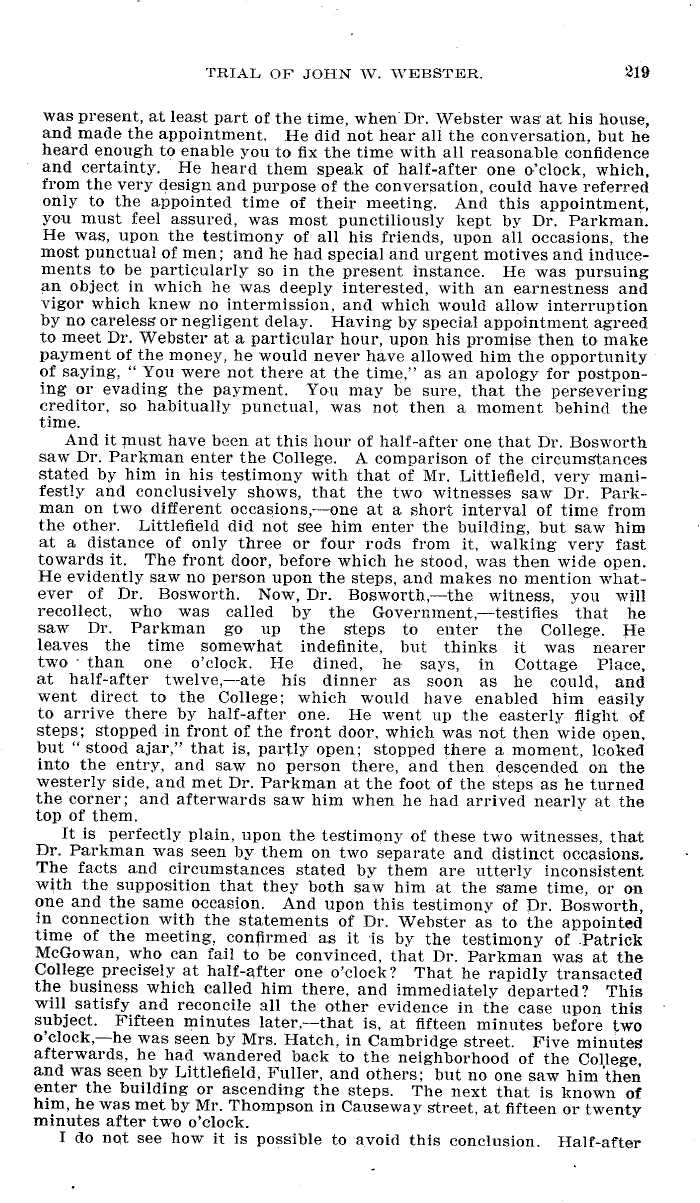|
TRIAL OF JOHN W. jvEBSTER. 219
was present at least part of the time, when Dr. Webster wag at his house,
and made the appointment. He did not hear all the conversation, but he
heard enough to enable you to fix the time with all reasonable confidence
and certainty. He heard them speak of half-after one o'clock, which,
from the very design and purpose of the conversation, could have referred
only to the appointed time of their meeting. And this appointment,
you must feel assured, was most punctiliously kept by Dr. Parkman.
He was, upon the testimony of all his friends, upon all occasions, the
most punctual of men; and he had special and urgent motives and induce-
ments to be particularly so in the present instance. He was pursuing
an object in which he was deeply interested, with an earnestness and
vigor which knew no intermission, and which would allow interruption
by no careless or negligent delay. Having by special appointment agreed
to meet Dr. Webster at a particular hour, upon his promise then to make
payment of the money, he would never have allowed him the opportunity
of saying, " You were not there at the time," as an apology for postpon-
ing or evading the payment. You may be sure, that the persevering
creditor, so habitually punctual, was not then a moment behind the
time.
And it must have been at this hour of half-after one that Dr. Bosworth
saw Dr. Parkman enter the College. A comparison of the circumstances
stated by him in his testimony with that of Mr. Littlefield, very mani-
festly and conclusively shows, that the two witnesses saw Dr. Park-
man on two different occasions,-one at a short interval of time from
the other. Littlefield did not see him enter the building, but saw him
at a distance of only three or four rods from it, walking very fast
towards it. The front door, before which he stood, was then wide open.
He evidently saw no person upon the steps, and makes no mention what-
ever of Dr. Bosworth. Now, Dr. Bosworth, the witness, you will
recollect, who was called by the Government,-testifies that he
saw Dr. Parkman go up the steps to enter the College. He
leaves the time somewhat indefinite, but thinks it was nearer
two - than one o'clock. He dined, he says, in Cottage Place,
at half-after twelve,--ate his dinner as soon as he could, and
went direct to the College; which would have enabled him easily
to arrive there by half-after one. He went up the easterly flight of
steps; stopped in front of the front door, which was not then wide open,
but " stood ajar," that is, partly open; stopped there a moment, lcoked
into the entry, and saw no person there, and then descended on the
westerly side, and met Dr. Parkman at the foot of the steps as he turned
the corner; and afterwards saw him when he had arrived nearly at the
top of them.
It is perfectly plain, upon the testimony of these two witnesses, that
Dr. Parkman was seen by them on two separate and distinct occasions.
The facts and circumstances stated by them are utterly inconsistent
with the supposition that they both saw him at the game time, or on
one and the same occasion. And upon this testimony of Dr. Bosworth,
in connection with the statements of Dr. Webster as to the appointed
time of the meeting, confirmed as it is by the testimony of .Patrick
McGowan, who can fail to be convinced, that Dr. Parkman was at the
College precisely at half-after one o'clock? That he rapidly transacted
the business which called him there, and immediately departed? This
will satisfy and reconcile all the other evidence in the case upon this
subject. Fifteen minutes later.-that is, at fifteen minutes before two
o'clock,-he was seen by Mrs. Hatch, in Cambridge street. Five minutes
afterwards, he had wandered back to the neighborhood of the College,
and was seen by Littlefield, Fuller, and others; but no one saw him then
enter the building or ascending the steps. The next that is known of
him, he was met by Mr. Thompson in Causeway street, at fifteen or twenty
minutes after two o'clock.
I do not see how it is possible to avoid this conclusion. Half-after
|

